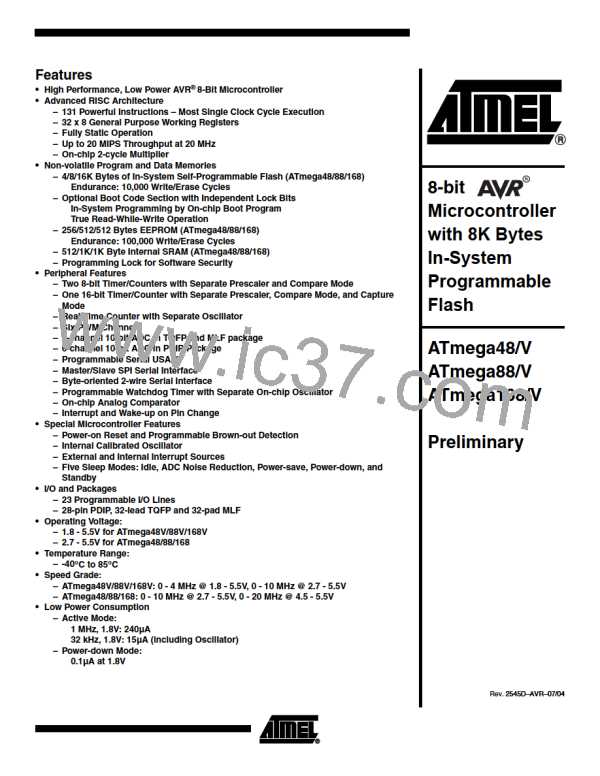Self-Programming
the Flash, ATmega48
In ATmega48, there is no Read-While-Write support, and no separate Boot Loader Sec-
tion. The SPM instruction can be executed from the entire Flash.
The device provides a Self-Programming mechanism for downloading and uploading
program code by the MCU itself. The Self-Programming can use any available data
interface and associated protocol to read code and write (program) that code into the
Program memory.
The Program memory is updated in a page by page fashion. Before programming a
page with the data stored in the temporary page buffer, the page must be erased. The
temporary page buffer is filled one word at a time using SPM and the buffer can be filled
either before the Page Erase command or between a Page Erase and a Page Write
operation:
Alternative 1, fill the buffer before a Page Erase
•
•
•
Fill temporary page buffer
Perform a Page Erase
Perform a Page Write
Alternative 2, fill the buffer after Page Erase
•
•
•
Perform a Page Erase
Fill temporary page buffer
Perform a Page Write
If only a part of the page needs to be changed, the rest of the page must be stored (for
example in the temporary page buffer) before the erase, and then be re-written. When
using alternative 1, the Boot Loader provides an effective Read-Modify-Write feature
which allows the user software to first read the page, do the necessary changes, and
then write back the modified data. If alternative 2 is used, it is not possible to read the
old data while loading since the page is already erased. The temporary page buffer can
be accessed in a random sequence. It is essential that the page address used in both
the Page Erase and Page Write operation is addressing the same page.
Performing Page Erase by
SPM
To execute Page Erase, set up the address in the Z-pointer, write “00000011” to
SPMCSR and execute SPM within four clock cycles after writing SPMCSR. The data in
R1 and R0 is ignored. The page address must be written to PCPAGE in the Z-register.
Other bits in the Z-pointer will be ignored during this operation.
•
The CPU is halted during the Page Erase operation.
Filling the Temporary Buffer
(Page Loading)
To write an instruction word, set up the address in the Z-pointer and data in R1:R0, write
“00000001” to SPMCSR and execute SPM within four clock cycles after writing
SPMCSR. The content of PCWORD in the Z-register is used to address the data in the
temporary buffer. The temporary buffer will auto-erase after a Page Write operation or
by writing the RWWSRE bit in SPMCSR. It is also erased after a system reset. Note that
it is not possible to write more than one time to each address without erasing the tempo-
rary buffer.
If the EEPROM is written in the middle of an SPM Page Load operation, all data loaded
will be lost.
Performing a Page Write
To execute Page Write, set up the address in the Z-pointer, write “00000101” to
SPMCSR and execute SPM within four clock cycles after writing SPMCSR. The data in
R1 and R0 is ignored. The page address must be written to PCPAGE. Other bits in the
Z-pointer must be written to zero during this operation.
248
ATmega48/88/168
2545D–AVR–07/04

 ATMEL [ ATMEL ]
ATMEL [ ATMEL ]